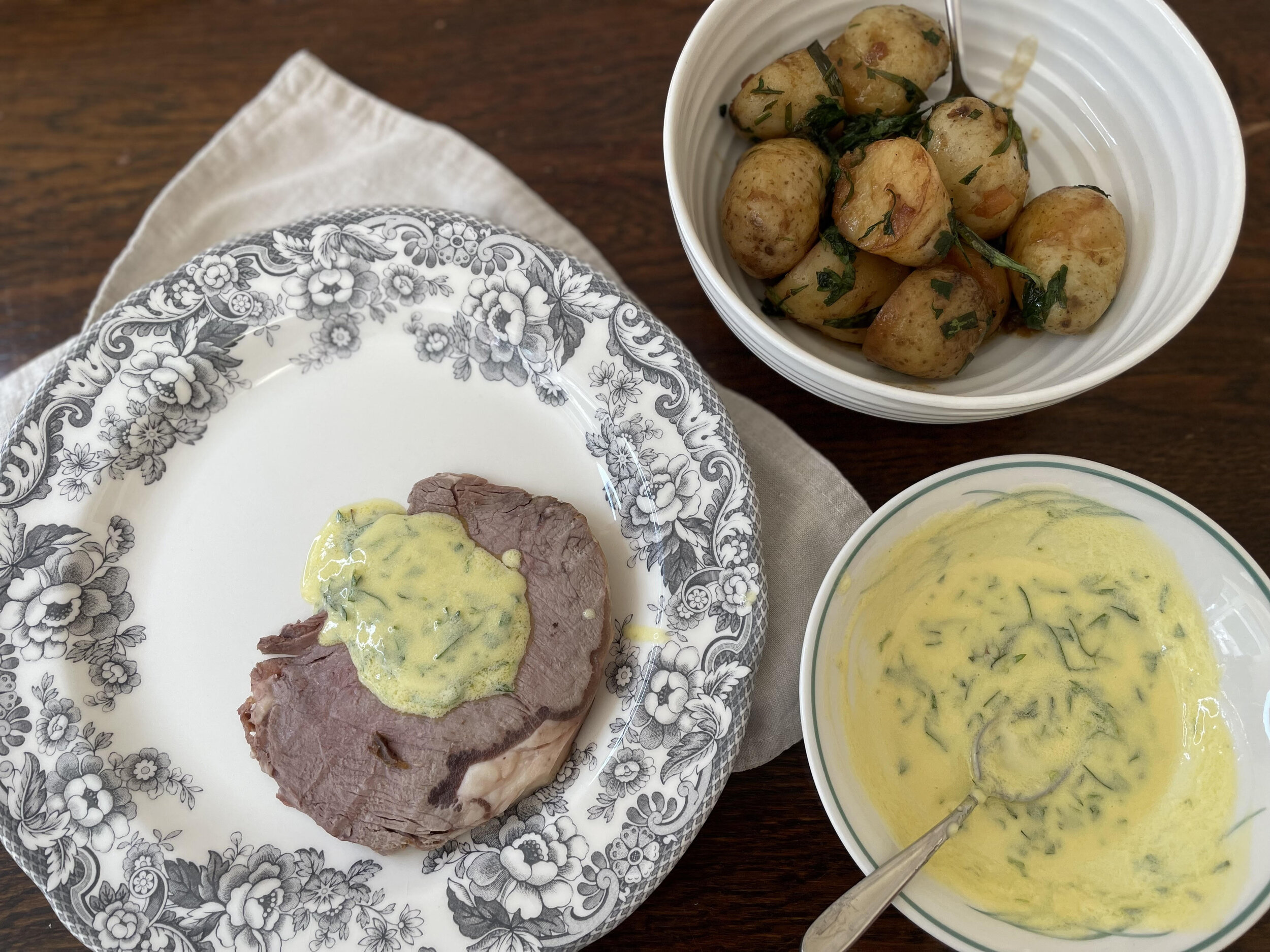roast rib of beef with basil hollandaise
A rib of beef is a pretty expensive piece of meat so this recipe calls for a special occasion: a big birthday, or special get-together with friends. I particularly like cooking this cut for a big group as it’s really very simple to do, nothing much more than seasoning and putting in the oven, leaving the chef free to enjoy themselves for much of the evening. The biggest challenge, I find, is in the carving. And I do admit to watching a few YouTube videos on how to do this properly! However, once you have the hang of it, that is easy too. And especially impressive if you can carve in front of your guests.
Hollandaise has a reputation for being quite difficult to get right. This reputation is justified to an extent but its saving grace is that if things go wrong, it can actually be rescued very easily. When preparing this basil hollandaise keep a sharp eye on the consistency as you are gradually adding the butter. If it starts to appear ‘greasy’ it is likely to split. Add a few drops of water or vinegar to stop this from happening. If the worst does happen and you do manage to split your sauce, simply beat another egg yolk and a tablespoon of water in a clean bowl of simmering water. When its light and slightly fluffy, take the bowl off the heat and slowly whisk in the broken sauce into the bowl. If you have any butter still to add, slowly add this into the mixture too.
You can serve the beef with whatever you like really, but my new favourite thing is to toss some boiled baby jersey royals in with the pan juices from the beef and lots of chopped herbs (parsley, tarragon and basil) for a side that’s full of flavour but not as heavy or wintery as roast potatoes or mash. I also serve some seasonal greens such as broccoli or asparagus.

Ingredients
Serves 8
1 large rib roast of beef (around 3kg)
60ml olive oil
Salt
Pepper
For the basil hollandaise
140ml white wine vinegar
Large bunch of basil, leaves picked and stalks roughly chopped
½ tsp salt
3 large egg yolks
250g butter
Squeeze lemon juice
1. Take the beef out of the fridge at least an hour before you want to cook it. Rub with oil, salt and pepper and leave to come up to room temperature. Preheat the oven to 220C.
2. Place the meat in a large roasting dish and put in the oven.
3. After 30-40 minutes, turn the oven down to 160C and let the rib continue to roast for a 70 minutes.
4. Remove from the oven. If you have a meat thermometer use it to check the internal temperature of the meat. According to the The Ginger Pig butchers in London, this should be around 50C for rare, 54C for medium rare, and 58C for medium. Leave to rest in a warm place.
5. While the meat rests, make a start on the hollandaise. If you are not going to serve your hollandaise straight away, start by boiling some water in the kettle and filling a thermos flask. Seal it and leave it somewhere handy.
6. Take your basil leaves and add them to a pestle and mortar with a small pinch of salt. Grind to a paste and set to one side.
7. Add the white wine vinegar and basil stalks and salt to a small saucepan. Bring to the boil and then let simmer over a medium heat until the liquid is reduced to about 4 tablespoons. While you wait, melt the butter (in the microwave, or in another small pan) and set to one side.
8. Strain the liquid into a double-boiler, or a heatproof bowl set over a pan of water. Make sure to give the mixture a good squeeze through the sieve so that you make the most of the flavour of the shallot and herbs.
9. Add the egg yolks. Bring the pan of water to a simmer and whisk the eggs. Do this continuously to help incorporate air and stop the eggs from cooking too quickly. When the yolks have doubled in volume, turn off the heat.
10. Add the butter. Start by adding just a few drops, whisking continuously until its incorporated. Then add a few more drops, while whisking, until the sauce begins to come together. Once this happens, you can gradually start to add the butter a little more quickly, in a thin trickle until all of it has been added, and the sauce is thick and creamy. If you don’t want to do this by hand, you can use a stick blender or electric whisk.
11. Add the basil paste and lemon juice to taste. If the sauce is very thick, then you can also add a teaspoon or so of water (this might also help prevent splitting).
12. Pour the hot water out of your thermos and transfer the warm hollandaise into it. Seal and then set aside until ready to serve. It will stay warm (and safe to eat) for 1-2 hours in the thermos.
13. Carve your beef (at the table if you are confident – it’s an impressive bit of meat!) and serve with some new potatoes tossed in the beef pan juices, seasonal vegetables, and the sauce.

